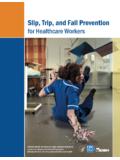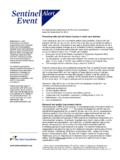Transcription of Preventing Slips, Trips, and Falls in the Workplace
1 Director s Column 2 Connecting Update 2 New Developments 3 Construction Update 4 General Industry Update 5 Consultation & Training Update 6 Technical Information 7 Vol. 16, No. 4 fall 2012 Preventing Slips, Trips, and Falls in the WorkplaceBy Brenda Cani, Safety Consultant CET DivisionSlips, trips, and Falls (STFs) are the number one cause of injuries in the Workplace and happen in all types of work environments. According to fed-eral OSHA, slips, trips, and Falls cause 15 percent of all Workplace deaths and are second only to motor vehicles as a cause of fatalities. STFs can result in head injuries, back injuries, broken bones, cuts and lacerations, sprained muscles, or even of the high rate of injuries and fatalities related to STF hazards, reducing these hazards is a priority of the MIOSHA Program.
2 Incidents caused by STFs, like any other work-place injuries, can be anticipated and prevented. MIOSHA rules for both construction and general industry re-quire employers to address the vari-ety of STF hazards in their a basic STF prevention program will help employers:n Understand how Workplace ac-cidents happen;n Identify the trouble areas; andn Eliminate and/or minimize the STF StatisticsIn 2010, the Bureau of Labor Statis-tics (BLS) indicated STFs accounted for percent of the total lost-work-day injuries reported. Of that percent, BLS reported slips and Falls on the same level (including slips and trips that do not result in a fall ) accounted for 74 percent of total lost-workday STFs, while Falls from an el-evation (including Falls from heights and Falls down stairs) accounted for 26 percent.
3 In Michigan, percent of all Workers Compensation cases were due to injuries sustained from falling or slipping on the have been a significant num-ber of fatal Falls in Michigan in the last three years. In 2010, there were eight fatal Falls and one slip/trip fatal-ity in general industry and three fatal Falls in construction. The numbers were reduced in 2011 to three in gen-eral industry and four in construction. To date in 2012 there was one in gener-al industry and three in construction. (Details are in the sidebar.)Slip/Trip/ fall HazardsSlips can occur when floors or other working surfaces become slip-pery due to wet or oily processes, floor cleaning, leaks, or from materials and debris left in walkways.
4 Trips can occur due to uneven floors or working surfaces, protruding nails and boards, from stretched carpet or bunched floor mats intended to prevent slipping, from holes or de-pressions in work-ing surfaces, and from step-risers on stairs that are not uniform in height. Both slips and trips can result in Falls . In addition, Falls can occur when ladders are not properly maintained, and when stair-ways and elevated working surfaces are not designed challenging, STF injuries can be prevented by training all staff to recognize and manage the environ-mental hazards that contribute to fall -related accidents.
5 In the Workplace , the primary STF hazards are:n Contaminants on the floor,n Wet surfaces,n Indoor/outdoor walking sur-face irregularities,n Weather conditions,n Inadequate lighting,n Stairs and handrails,n Stepstools and ladders,n Tripping hazards, andn Elevated working Prevention ProgramIn 2008, a National Institute of Occupational Safety and Health (NIOSH) study documented that im-plementing a slip, trip, and fall pre-vention program reduces STF injuries and workers compensation claims. Each type of STF may require differ-ent features in a prevention of a Slip, Trip, and fall Prevention Program should include:1.
6 Plan: Identify key risk areas and set goals for Organize: Involve workers and assign responsibilities so they are committed to the Worksite Analysis: Assess the risk to employees, to visitors, and to the public. Periodically review to be sure all hazards are Hazard Prevention and Con-trol: Ensure work practices and pro-cesses are being carried out properly and that they are being Safety and Health Training: Provide essential training at all levels, including Take Control: Establish poli-cies and procedures to reduce the number of help with STFs, contact the CET Division at Fatalities2012 4*General IndustryDriver: Fell from back of truck trailerConstructionPainter: Fell from suspension bridgePlumber/Owner: Fell from ladderRoofer.
7 Fell through roof to ground level2011 7 General IndustryElectrician: Changing light bulb and fell off ladderOwner: Fell from 7-foot height to surface belowCo-owner: Fell 40 feet during tree cutting operationConstructionCarpenter: Fell setting trussesLaborer: Fell while roofingProject Manager: Fell into man-hole, was asphyxiatedRoofer: Fell 49 feet from ladder2010 12 General IndustryLaborer: Fell from tailgate of ATVM aintenance Worker: Fell to the bottom of stairwayLoader: Fell from railroad boxcarFood Service: Slipped on ice and fell down stepsSupervisor: Fell from ladderTruck Driver: Slipped/fell out of truckRanch Worker: Fell through trap doorFire Chief: Fell in fire station equip-ment areaOwner: Fell from ladderConstructionLaborer: Fell cutting down beamsCarpenter: Fell from ladderRoofer: Fell through roof cover*Through 09/30/1205101520181715131310654 RoofLadderOther/UnknownScaffolding/Stagi ngNonmoving VehicleOn Same LevelFloor/Dock/Ground LevelBuilding Girders/Structural SteelDown Stairs/Steps2008 Fatal Falls By Type of Fall700 Fatal Falls By PercentageSource: Bureau of Labor Statistics, Department of.
8 Percentages may not add to totals because of News fall 2012 Page 2 DIreCTor s ColUmNCoNNeCTING UpDaTemartha YoderDirectorBart pickelman, CIHD eputy DirectorWorkplace Risk AssessmentAre you adequately assessing the risk associated with each job at your Workplace ?MIOSHA was recently reminded of the importance of proactively using risk assessment methods to minimize exposures to existing and potential Workplace , state occupational safety and health programs are evaluated by federal OSHA to determine whether the program is at least as effective as federal OSHA. The review assesses progress toward strategic plan goals and makes recommendations to im-prove program recommendation from the FY 2011 report encouraged MIOSHA management to be sure enforcement case files are reviewed to verify that hazards are properly invited federal OSHA to pro-vide an overview of their approaches, and on September 12th, MIOSHA su-pervisors and managers met with four federal OSHA managers.
9 The session was productive and a good most significant take away was that MIOSHA Workplace reviews are, in essence, a review of the risk as-sessment and reduction efforts taken by employers to minimize or elimi-nate Operation TragedyOne example brought this point home in a powerful way. It was a vid-eo of a stamping operation making jigsaw puzzles. A young female op-erator was protected by distance from the point of operation of the press by a work table over five feet operator stood at the table with a hand tool to pull the puzzles toward her, removed the frame, and then moved the puzzle to a conveyor.
10 At first look, this seemed like a good approach for safeguarding the em-ployee. However, soon several puz-zles came out of the press with pieces missing. The operator used the hand tool to pull the missing pieces out of the press no problem. Then a puzzle had one missing piece that was stuck in the press. The operator was unable to dislodge the piece with the hand tool. Trying to get the job done, she climbed on the table and shimmied into the press just as the press cycled. Sadly, she lost both hands and part of both arms in the , our familiarity with a job can inappropriately lead us to perceive a relatively low level of risk.














